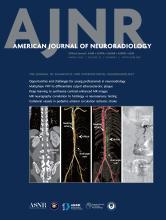This article requires a subscription to view the full text. If you have a subscription you may use the login form below to view the article. Access to this article can also be purchased.
Abstract
BACKGROUND AND PURPOSE: Accurate pretreatment diagnosis and assessment of spinal vascular malformations using spinal CTA are crucial for patient prognosis, but the postprocessing reconstruction may not be able to fully depict the lesions due to the complexity inherent in spinal anatomy. Our purpose was to explore the application value of the spinal subtraction and bone background fusion CTA (SSBBF-CTA) technique in precisely depicting and localizing spinal vascular malformation lesions.
MATERIALS AND METHODS: In this retrospective study, patients (between November 2017 and November 2022) with symptoms similar to those of spinal vascular malformations were divided into diseased (group A) and nondiseased (group B) groups. All patients underwent spinal CTA using Siemens dual-source CT. Multiplanar reconstruction; routine bone subtraction, and SSBBF-CTA images were obtained using the snygo.via and ADW4.6 postprocessing reconstruction workstations. Multiple observers researched the following 3 aspects: 1) preliminary screening capability using original images with multiplanar reconstruction CTA, 2) the accuracy and stability of the SSBBF-CTA postprocessing technique, and 3) diagnostic evaluation of spinal vascular malformations using the 3 types of postprocessing images. Diagnostic performance was analyzed using receiver operating characteristic analysis, while reader or image differences were analyzed using the Wilcoxon signed-rank test or the Kruskal-Wallis rank sum test.
RESULTS: Forty-nine patients (groups A and B: 22 and 27 patients; mean ages, 44.0 [SD, 14.3] years and 44.6 [SD,15.2] years; 13 and 16 men) were evaluated. Junior physicians showed lower diagnostic accuracy and sensitivity using multiplanar reconstruction CTA (85.7% and 77.3%) than senior physicians (93.9% and 90.9%, 98% and 95.5%). Short-term trained juniors achieved SSBBF-CTA image accuracy similar to that of experienced physicians (P > .05). In terms of the visualization and localization of spinal vascular malformation lesions (nidus/fistula, feeding artery, and drainage vein), both multiplanar reconstruction and SSBBF-CTA outperformed routine bone subtraction CTA (P = .000). Compared with multiplanar reconstruction, SSBBF-CTA allowed less experienced physicians to achieve superior diagnostic capabilities (comparable with those of experienced radiologists) more rapidly (P < .05).
CONCLUSIONS: The SSBBF-CTA technique exhibited excellent reproducibility and enabled accurate pretreatment diagnosis and assessment of spinal vascular malformations with high diagnostic efficiency, particularly for junior radiologists.
ABBREVIATIONS:
- AP
- arterial phase
- AUC
- area under the curve
- CE-MRA
- contrast-enhanced MRA
- MPR-CTA
- multiplanar reconstruction CTA
- RBS-CTA
- routine bone subtraction CTA
- ROC
- receiver operating characteristic
- SSBBF-CTA
- spinal subtraction and bone background fusion CTA
- SVM
- spinal vascular malformation; 3D-VR =3D volume-rendering
- © 2024 by American Journal of Neuroradiology







